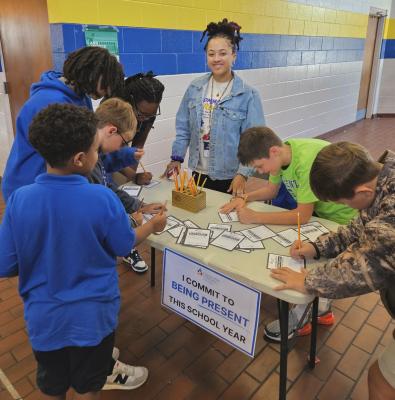Governor Josh Stein recently declared September as Attendance Awareness Month in North Carolina, a timely and needed focus for the state. Chronic absenteeism, defined as missing 10% or more days of school or ~18 days in typical school year, doubled nationally after the pandemic and North Carolina has followed a similar trend. Rising from 16% pre-pandemic to a peak of 32% in 2021–22, roughly 25% of students were chronically absent during the 2024–25 school year. Put simply, roughly one in four North Carolina students (~375,000), missed a month or more of school last year. To achieve North Carolina’s goal of reducing chronic absenteeism to 11% by 2030, schools will need collaborative, research-informed solutions to help students get to school and stay on track. A recent review of the research led by Sarah Montello, a doctoral candidate at North Carolina State University and graduate intern for the Office of Research and Promising Practices at the North Carolina Department of Public Instruction (NCDPI), highlights multiple, interacting forces that contribute to chronic absenteeism:
- Student and family factors: Challenges such as anxiety, school disengagement, housing instability and financial stress can all make regular attendance difficult.
- School conditions: Negative school climate and exclusionary discipline practices can unintentionally push students away from class.
- Community and policy barriers: Transportation gaps, limited healthcare access and community safety concerns often create obstacles that schools cannot solve alone.
Breaking the Cycle

Chronic absenteeism carries serious consequences for students and schools. Research shows that chronically absent students face higher risks of lower grades, reduced GPAs and ultimately dropping out of high school. Absenteeism also affects peers, especially in elementary classrooms, where missing classmates can weaken the sense of community and make poor attendance more likely to spread. Left unaddressed, these effects compound over time, making it increasingly difficult for students to catch up.
Fortunately, early intervention and community-wide strategies can help turn the tide. Evidence from the research literature points to multi-tiered, relationship-centered approaches for reducing absenteeism, such as:
- Early warning systems and attendance teams: Schools that track daily attendance in real time and assign teams to respond quickly can catch problems before they become chronic.
- Family outreach: Personalized texts, calls and even home visits help families feel supported while reinforcing the importance of getting students back in class.
- Positive engagement and incentives: Celebrations, recognition and small rewards can motivate students to rebuild daily routines and strengthen their sense of belonging.
- Integrated student supports: Coordinating school and community resources such as health, social and academic services can help address the academic and non-academic barriers that often keep students out of the classroom.
One absenteeism bright spot is Communities In Schools, which has partnered with more than 200 schools across North Carolina to remove barriers to regular school attendance. This year, it launched its “Pledge to Be Present” campaign, calling on students, families, educators and community partners to make school attendance a priority.
“Across North Carolina, we’re proving that when schools, families and communities work together, students show up,” said Jill K. Cox, President & CEO of Communities In Schools of North Carolina. “Initiatives like Pledge to be Present complement the day-to-day relationships our specialists build with students by removing barriers, celebrating progress and restoring the habit of daily attendance.”
Part of the Plan
Attendance is foundational to the State Board of Education and NCDPI’s joint strategic plan for Achieving Educational Excellence, which prioritizes preparing every student for the next phase in life while grounded in strong academics, character and making North Carolina’s public schools the best in the nation.
“An absent child can’t be taught by our educators. Our plan is about making sure students are present, engaged and supported every day,” said North Carolina Superintendent of Public Instruction Maurice “Mo” Green. “That means fostering positive school climates, using data effectively and strengthening partnerships with families and community organizations across North Carolina.”
In alignment with Pillar 4 of the Strategic Plan, the Office of Research & Promising Practices (ORPP) is advancing the action to “identify and share effective practices for reducing chronic absenteeism and strengthening student attendance.” As a first step toward that milestone, NCDPI will release a practitioner-focused research brief this fall that summarizes key findings from the literature on chronic absenteeism and provides evidence-based strategies for schools and districts. The ORPP will also publish the full technical literature review for the education research community to support deeper analysis and future study.
Next spring, the ORPP will launch a “bright spots” research pilot using an asset-based approach with a small cohort of volunteer districts representing diverse contexts. The pilot will identify schools that consistently outperform peers on attendance, document the concrete practices that set them apart through site visits and stakeholder interviews, and help participating districts adapt and test those practices through rapid improvement cycles. The aim is to reduce chronic absenteeism by up to 20% while building a toolkit others can use to replicate the promising practices of these bright spot schools.
“Attendance is the first condition for learning and its decline now touches every student, not just those who have historically struggled,” noted Dr. Michael Maher, NCDPI Chief Accountability Officer. “From honors courses to early literacy, missed days quietly erode progress. By advancing Pillar 4’s commitment through rigorous research and on-the-ground improvement work, we can scale what’s already working in North Carolina and help more students show up, stay engaged and succeed.”

